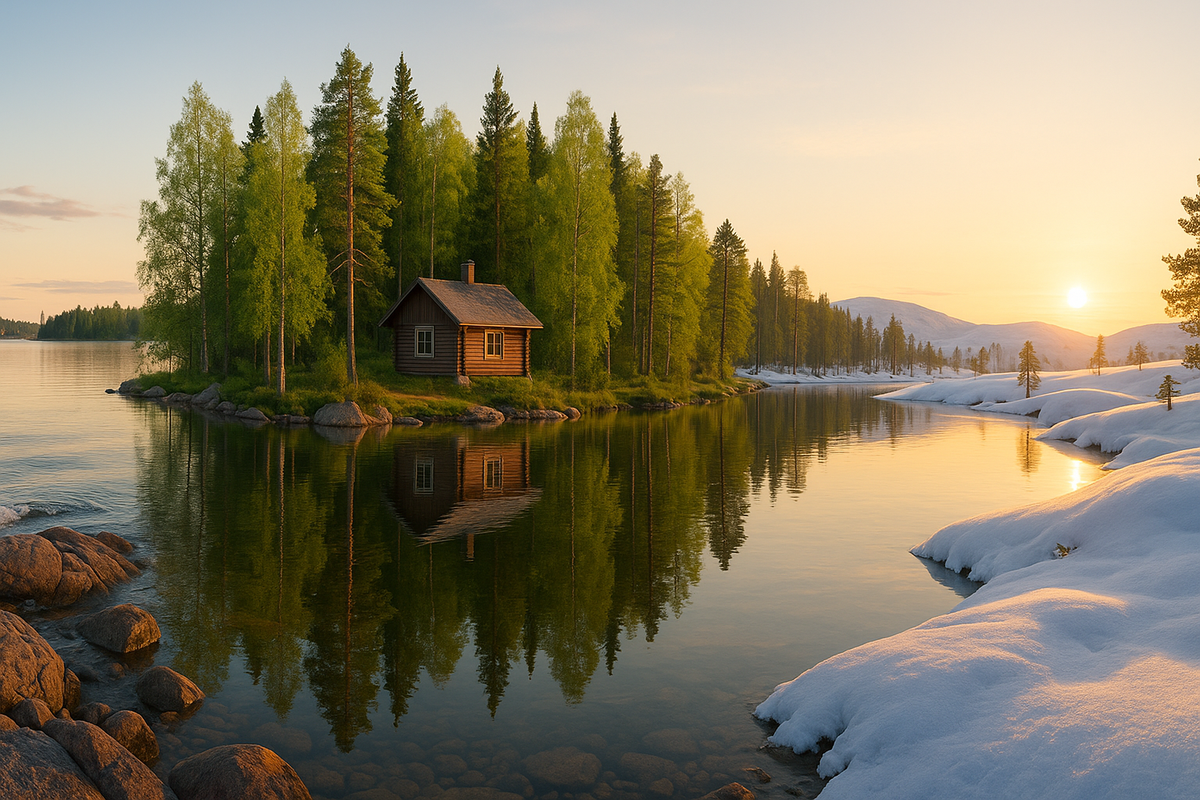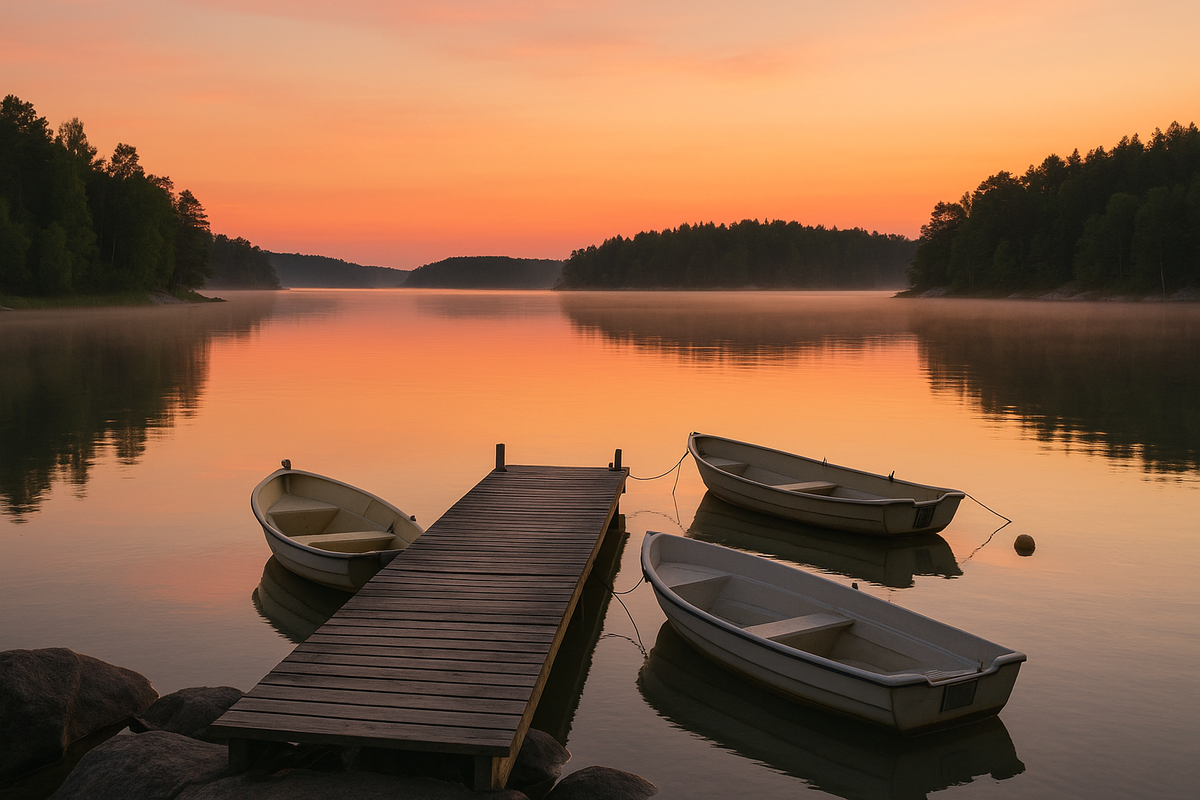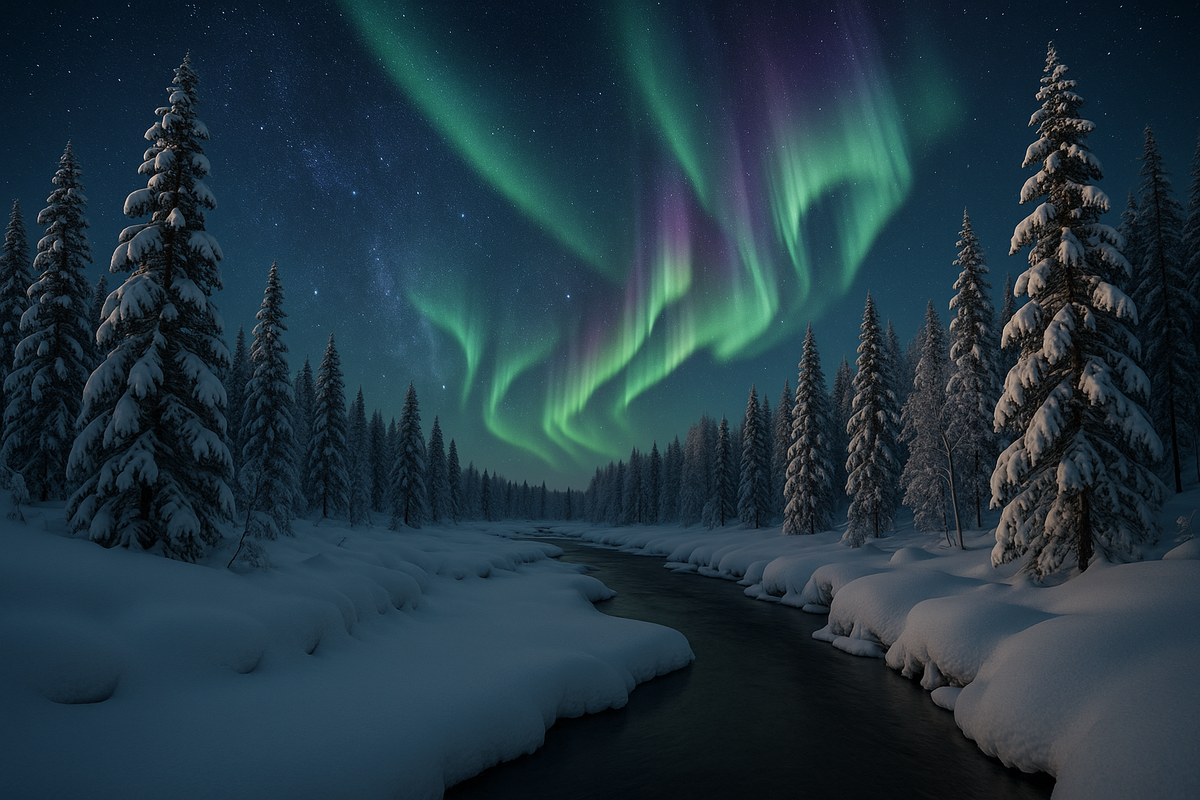🌍 Weather and seasons in Finland: when to go and what to plan for
Finland is a country where summer stretches into long twilights, and winter sparkles with dry snow and short 'blue' light. This handy guide is perfect for those of you who like to travel on your own. It will help you to understand the climate, choose a month and region, and get to know the wind on the Baltic Sea and the fog on the lakes. You can take a 'capsule' of things to pack, and plan an active holiday — from island hopping in the Turku/Åland archipelago Åland to skiing in Levi and hunting for the northern lights in Inari. I've put together a little summary below of the norms and typical ranges, so you know what to expect.

How the climate works: north-south, sea-inland
The southern coast (Helsinki, Turku, Åland/Ahvenanmaa) is lovely in winter, but it's also a bit windier. The breeze lowers the 'feels like' temperature by 2–4 °C, which is a real bonus. You'll find it a little warmer during the day in summer in inland areas like Tampere and the Lake District (Saimaa, Päijänne), with cooler nights. The west and the beautiful Gulf of Bothnia (Oulu, Kemi) are known for their windy evenings and mornings where you'll often find fog rolling in. Lapland (Rovaniemi, Saariselkä, Inari) is a place where you can enjoy stable snow and short days in winter, and in summer you can experience the enchanting polar day and cool nights.
🌦️ Seasons by region in Finland
☀️ Which month is usually the warmest, and how do the south and Lapland differ?
July is usually the warmest. In the south (Helsinki, Turku, Tampere), daytime temperatures are usually +18...+24 °C, and night-time temperatures are +12...+16 °C. In Lapland (Rovaniemi, Inari), daytime temperatures range from +14 to +20 °C, and night-time temperatures from +6 to +12 °C. However, the days are longer and the air is drier, making it pleasant to go hiking and cycling. The Baltic breeze makes it feel 2–4°C colder, so a light windbreaker jacket and a scarf-buff will come in handy on the embankments and in the archipelago, even on warm days.

❄️ What is the typical temperature in January in Helsinki and Rovaniemi, and how does the wind affect it?
In Helsinki, the daytime temperature is usually 0...−5 °C, and at night −4...−9 °C; thaws are possible. In Rovaniemi, the daytime temperature is −10...−18 °C, and at night −15...−25 °C — dry continental cold is easier to tolerate than ‘wet’ coastal cold. With winds of 8–10 m/s, the ‘wind chill’ at the sea drops by another 3–6 °C. On open embankments, protect your face and eyes from snow flurries; in the city, microspikes will help after transitions from ‘plus → minus’.
🌙 How much light is there in Turku in June, and how do white nights differ from the polar day?
In Turku and Helsinki at the end of June, there are about 19 hours of daylight, and ‘night’ is light twilight: you can walk and take photos without a torch. The polar day is a different story: north of the Arctic Circle (Saariselkä, Inari), the sun does not set at all from around the end of May to the end of July. If the light prevents you from sleeping, a mask and thick curtains will help. For active people, there is a plus: late walks, light hikes and evening SUP rides.
🌧️ How much rain and thunderstorms are there in summer, and how should you plan your day?
In summer, most regions receive 50–80 mm of precipitation per month. Showers are usually localised and short-lived: a ‘grey’ morning often ends in a clear afternoon. Thunderstorms occur in the afternoon; sea fronts reach the west coast and archipelagos (Turku, Åland/Ahvenanmaa) faster. A convenient rhythm: plan active activities for the first half of the day, leaving ‘plan B’ (museums, sauna, coffee shops) for fronts and gusty winds.
🌊 What is the water temperature in Helsinki in July and in the Saimaa lakes in August?
The Baltic Sea off the coast of Helsinki is usually +15...+19 °C in July. In the sheltered bays of the Turku and Åland archipelagos, the water stays at +17...+21 °C. In the Saimaa and Päijänne lakes, the end of July and August often bring temperatures of +18...+22 °C in shallow bays. At sea, take upwelling into account — under certain winds, the water can ‘drop’ by 2–5 °C per day; on such days, choose closed bays or lakes. Swim near the shore and wear life jackets on SUPs/kayaks.
🍁 When is the peak of ruska and where is the best place to catch the colours?
In Lapland, the peak is usually in mid-September (Rovaniemi, Saariselkä, Inari), and in the south — 2–3 weeks later (Nuuksio, Koli, Repovesi). Strong winds and prolonged rain accelerate leaf fall, so plan for 2–3 ‘flexible’ days. Good panoramic spots: Koli Plateau, Oulanka ridges, markers on the hills in Levi/Ylläs. It is cooler and windier on the plateau — add a membrane and a hat, and take short loops in the forest during windy hours.

🌌 When is the best time to hunt for the Northern Lights and where are the chances higher?
From late August to March — long nights and dark skies. The further north, the better: Rovaniemi, Saariselkä, Inari, and Utsjoki. The main enemy is cloud cover, so allow for 2–3 nights and get away from city lights. During a new moon, the images are more contrasting, but the moon is not critical if the sky is clear. Dress for winter: standing still is colder than walking; a thermos and insulation for camera batteries are a great idea.
🦟 Where and when are there more mosquitoes, and how can you mitigate the situation?
They peak in late June–July in the wooded and humid areas of the Lake District and Lapland. There are fewer of them on the windy islands of the archipelagos, on open hills and by the sea. Essential kit: repellent, a light long-sleeved jacket, a net for your pram/camping entrance. On windy days on the coast and towards the end of August, it becomes easier. For overnight stays by the water, choose a spot with a windy shore and stay away from marshy lowlands.
🚗 Do tourists need studded tyres in winter and how to walk on ice in the city?
Rental cars in Finland are usually equipped seasonally — studded or friction winter tyres are fitted in advance. Plan your trips during the day anyway: it is easier and safer in daylight. In cities, after a thaw and sub-zero temperatures at night, ‘black ice’ appears — compact ice cleats (microspikes) are really helpful for walking. Only go out onto natural ice on officially open routes and proven lake tracks.
⛷️ When do Levi/Ruka/Ylläs open and how long does the snow last?
Thanks to snow conservation, Ruka and sometimes Levi start at the end of October–November; the ‘high’ season in terms of reliability is December–March. In severe frosts, the snow is ‘crunchy’, so it is better to ski during the day; in spring, the morning hours are best for hard corduroy. The wide blue slopes of Levi/Ylläs are convenient for families and beginners; book accommodation in advance for the Christmas and New Year weeks and February.
⛴️ How do storms in the Baltic Sea and upwelling affect plans by the sea?
Storm winds tend to come in waves in autumn and winter, but there are also ‘windy windows’ in summer. Ferries may change their schedules in case of high gusts and waves: choose flexible fares and leave a spare day for island hopping in Turku/Åland. In summer, keep an eye on the upwelling: with steady winds, the water near the shore can cool down sharply — moving your swimming to lakes or closed bays will restore comfort.
📅 Month-by-month climate cheat sheet (South vs Lapland)
What to bring: a ‘capsule’ for the city and nature
Summer and off-season: base layer, fleece/jumper, light membrane; water-repellent footwear, sunglasses and SPF, backpack cover. For water activities — footwear for rocky bottoms and life jackets for children. Winter: thermal underwear (wool/synthetic), insulating layer (fleece/down), membrane; mittens are warmer than gloves, buff/balaclava and clear glasses for wind protection. In cities after the thaw — ice cleats. For Lapland in winter, add spare gloves and a battery/power bank in a warm pocket.
Finland is generous to those who plan with an eye on light, wind and water. Choose the scenario that suits you — from the white nights and skerries of Turku/Åland to the ruski on Koli and the ‘hard’ spring snow on Levi. Leave a spare day in your itinerary, take ‘smart’ layers, check the forecast and warnings — and any weather will work in your favour.
Share this article with your friends and save it for yourself so you can refer back to the tables before you travel. Write your plans, questions and life hacks in the comments — we will be happy to respond and update the guide.
❓ FAQ
May–June and late August–September: daytime temperatures are usually +15...+22 °C, long daylight hours, moderate rainfall. July is warmer, but demand/prices are higher.
No. In Helsinki/Turku in June, there is light twilight without a real night; the polar day (when the sun does not set) begins north of the Arctic Circle — Inari, Saariselkä.
More often lakes Saimaa and Päijänne at the end of July–August (+18...+22 °C in shallow bays). At sea, upwelling is possible: the water cools by 2–5 °C per day.
For walks along the embankments, ~5–6 m/s is comfortable. For beginners on the water — calm/early morning; at ≥6–8 m/s, change your route or go to sheltered straits.
No. In the south, snow is unstable and comes in waves. For reliable coverage, go to Lapland: usually from late November to March–April.
From September to March, especially in Lapland (Rovaniemi, Saariselkä, Inari). Allow 2–3 nights and get away from city lights; the main enemy is cloud cover.
The peak is in late June–July in wooded and humid areas. It's easier on the coast and on windy islands; repellent, light closed clothing and choosing campsites without stagnant water help.
A light windproof and waterproof jacket. In the Baltic region, it adds 2–4°C of ‘comfort’ even on a warm day.
Sometimes. Autumn/winter storms disrupt ferries, and snowstorms disrupt some train/bus services. Keep flexible tickets and allow 20–30% extra time.
Only on officially open tracks with verified thickness. After thaws and winds, the ice breaks quickly — choose lake loops marked by the municipality.





0 comments
Log in to leave a comment